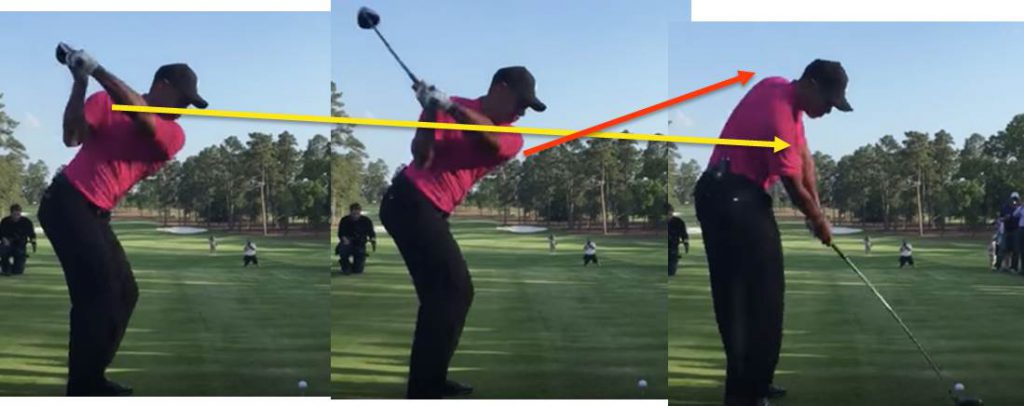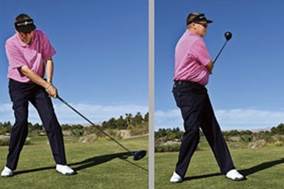Reduce Swing Movement for Better Ball Flight, Consistency, and Safety from Injury
Why and How Should Overall Swing Movement be Reduced?- Why should overall movement be reduced?
- How should whole-body movement be reduced
- How will it improve your full-swing and give you more swing-satisfaction?
 The next movement to consider is the down-then-up-again one (red arrow in the picture). This has become popular in recent times, with many golf instructors advocating a squat-jump type of downswing movement, as they believe that once a person squats, the ground pushes that person up again (ground reaction force or GRF), which will help to raise the lead hip and thus lead shoulder. If the lead shoulder can be high at impact, the lead shoulder and arm can form a long lever which gives better club speed. The issues with this are three. Firstly, there is no proof for GRF pushing a person, and it does not make sense either. A simple explanation is that if one stands on a basic weighing scale, the number shown on the dial represents the force one is applying on the scale, which should be matched by the ground. If the scale is put on even a fine carpet (or grass!), that number increases. Does that mean a carpet pushes us up more forcefully than a hard floor? If so, why do we have a tougher time getting out of a squishy sofa than a firm one? Secondly, the loads on the spine, hips and knees are at their highest at the lowest point in the squat, making it a risk factor for injury. Thirdly, the down-then-up-again move is silly is because if one stood maximally upright throughout the swing and simply allowed the trail arm to straighten, it will automatically push the lead side up (at least that is the case with the Minimalist Golf swing – MGS). This, then, is another movement one can easily discard. How about the side-to-side movement golfers refer to as weight-shift? Some “experts” believe that one can use the frictional force of the trail leg against the ground to push off off, but it is difficult to push off a leg that has a large proportion of the body’s weight going through it (try standing on just your trail leg then attempting a push off it, to understand).This movement can give the swing some starting momentum if a golfer is quick enough to shift weight forward at the beginning of the downswing, but comes at a high cost. If a golfer is not fast and strong enough to shift weight at the beginning of the movement, the torso, which has been “wound up” during the backswing begins its rotation, leaving the golfer’s weight stuck on the back leg, resulting in that very common and dreaded slice. So, side-to-side movement should be reduced to a great extent too.
The next movement to consider is the down-then-up-again one (red arrow in the picture). This has become popular in recent times, with many golf instructors advocating a squat-jump type of downswing movement, as they believe that once a person squats, the ground pushes that person up again (ground reaction force or GRF), which will help to raise the lead hip and thus lead shoulder. If the lead shoulder can be high at impact, the lead shoulder and arm can form a long lever which gives better club speed. The issues with this are three. Firstly, there is no proof for GRF pushing a person, and it does not make sense either. A simple explanation is that if one stands on a basic weighing scale, the number shown on the dial represents the force one is applying on the scale, which should be matched by the ground. If the scale is put on even a fine carpet (or grass!), that number increases. Does that mean a carpet pushes us up more forcefully than a hard floor? If so, why do we have a tougher time getting out of a squishy sofa than a firm one? Secondly, the loads on the spine, hips and knees are at their highest at the lowest point in the squat, making it a risk factor for injury. Thirdly, the down-then-up-again move is silly is because if one stood maximally upright throughout the swing and simply allowed the trail arm to straighten, it will automatically push the lead side up (at least that is the case with the Minimalist Golf swing – MGS). This, then, is another movement one can easily discard. How about the side-to-side movement golfers refer to as weight-shift? Some “experts” believe that one can use the frictional force of the trail leg against the ground to push off off, but it is difficult to push off a leg that has a large proportion of the body’s weight going through it (try standing on just your trail leg then attempting a push off it, to understand).This movement can give the swing some starting momentum if a golfer is quick enough to shift weight forward at the beginning of the downswing, but comes at a high cost. If a golfer is not fast and strong enough to shift weight at the beginning of the movement, the torso, which has been “wound up” during the backswing begins its rotation, leaving the golfer’s weight stuck on the back leg, resulting in that very common and dreaded slice. So, side-to-side movement should be reduced to a great extent too.  How about rotary movement, or the typical coil-and-uncoil motion that most golf swings have to some extent or the other? The downswing “uncoil” is a spontaneous movement (especially if the backswing has stretched the muscles or the torso adequately) and thus totally “free”. It is spontaneous because if the core muscles (external obliques and even the pectoralis major) have been stretched (as they are in the MGS), they contract very forcefully, because of a spring-like action of muscles, or the stretch-shortening cycle. Although the rotary movement is “free”, it is important for it to be produced in the correct sequence of lower-body before upper-body. If produced correctly, it is able to deliver both better distance (through a summation-of-forces principle) and better direction (as the only known movement to allow the club to arrive at the ball from a natural, inside path). Thus, the one movement which a golf swing must have is the rotary one, while all other whole-body movements can safely be eliminated altogether or reduced to a great extent. The next blog post will explain how to guaranty a correct sequence for the all-important body rotation.
How about rotary movement, or the typical coil-and-uncoil motion that most golf swings have to some extent or the other? The downswing “uncoil” is a spontaneous movement (especially if the backswing has stretched the muscles or the torso adequately) and thus totally “free”. It is spontaneous because if the core muscles (external obliques and even the pectoralis major) have been stretched (as they are in the MGS), they contract very forcefully, because of a spring-like action of muscles, or the stretch-shortening cycle. Although the rotary movement is “free”, it is important for it to be produced in the correct sequence of lower-body before upper-body. If produced correctly, it is able to deliver both better distance (through a summation-of-forces principle) and better direction (as the only known movement to allow the club to arrive at the ball from a natural, inside path). Thus, the one movement which a golf swing must have is the rotary one, while all other whole-body movements can safely be eliminated altogether or reduced to a great extent. The next blog post will explain how to guaranty a correct sequence for the all-important body rotation. 